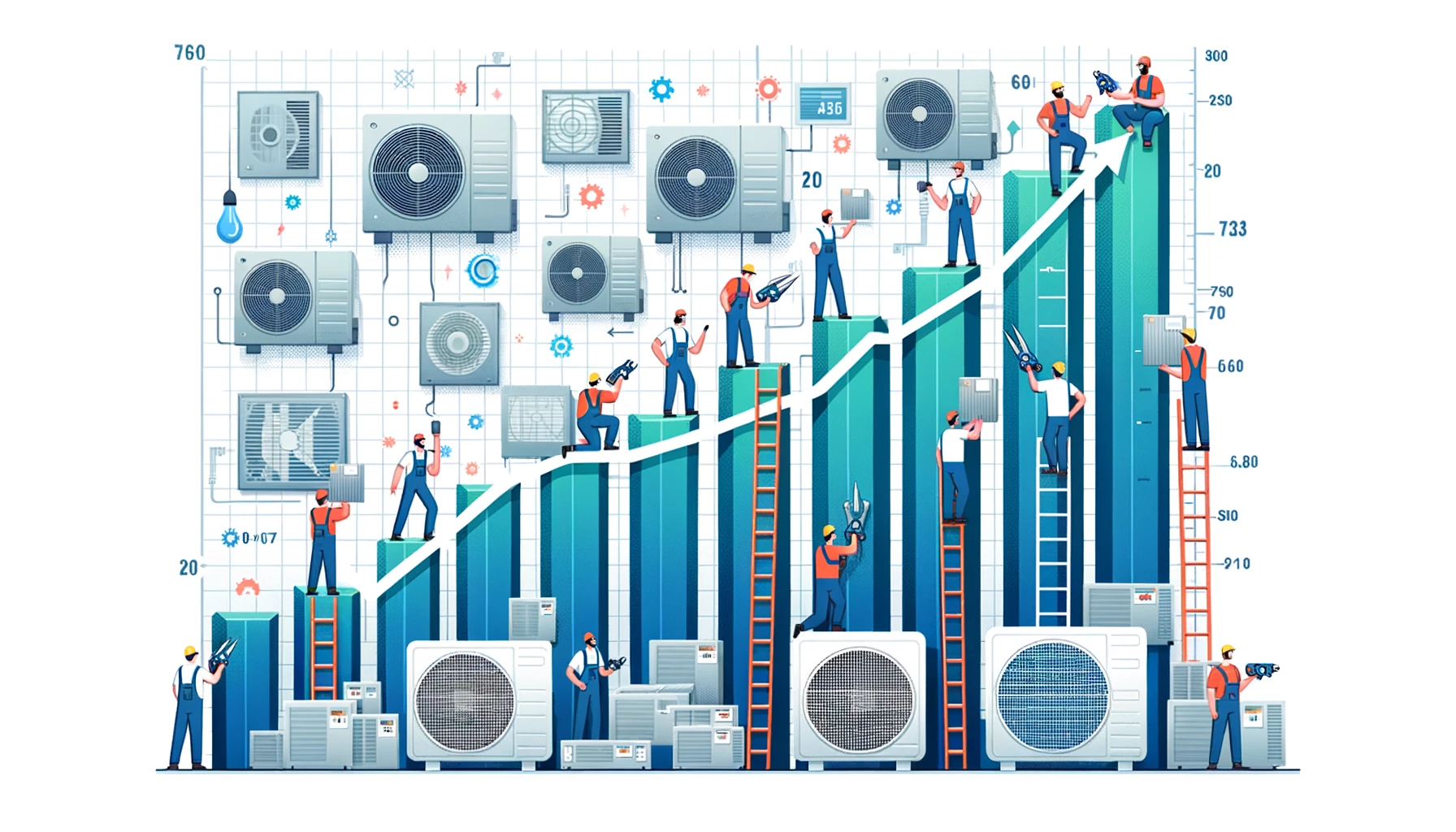The HVAC (Heating, Ventilation, and Air Conditioning) industry is one of the cornerstones of modern living. Whether it’s keeping our homes cozy in the winter, cool in the summer, or ensuring fresh air circulation in commercial buildings, HVAC systems play a crucial role. The market size and growth statistics of the HVAC industry vary significantly by region and the type of HVAC system in question. In this article, we will explore key findings and trends in the HVAC market, shedding light on its size, projected growth, and the factors influencing its trajectory.
The U.S. HVAC Systems Market: A Thriving Giant
Let’s begin with a close look at the United States, one of the largest and most influential markets for HVAC systems. According to a report from Grand View Research, the U.S. HVAC systems market was valued at a staggering USD 17.15 billion in 2022. The prospects look even more promising, with a projected compound annual growth rate (CAGR) of 6.5% from 2023 to 2030 (Source).
This growth can be attributed to several factors. First, the increasing need for energy-efficient and eco-friendly HVAC systems is driving innovation in the industry. As environmental concerns gain prominence, consumers are seeking greener alternatives that not only reduce their carbon footprint but also lower long-term operational costs.
Moreover, the growing awareness of indoor air quality (IAQ) has prompted a surge in demand for advanced ventilation and filtration systems. With the ongoing COVID-19 pandemic highlighting the importance of clean and well-ventilated spaces, HVAC manufacturers are incorporating cutting-edge technologies to meet these requirements.
Global HVAC Systems Market: A Giant on the Rise
While the U.S. dominates the HVAC systems market, it’s essential to consider the global perspective. The global HVAC systems market was valued at a whopping USD 136.3 billion in 2022, as reported by Grand View Research (Source). This colossal market is poised for substantial growth, with a projected CAGR of 6.3% from 2023 to 2030.
The global HVAC industry’s expansion is fueled by similar factors as the U.S. market, albeit on a larger scale. The increasing adoption of HVAC systems in emerging economies, coupled with the need for energy-efficient solutions worldwide, is propelling the market forward. Additionally, stringent regulations related to energy efficiency and environmental sustainability are compelling HVAC manufacturers to innovate and develop greener technologies.
North America: A Region of Steady Growth
Zooming in further, the North American HVAC system market is worth examining. According to Fortune Business Insights, it was valued at USD 41.67 billion in 2021, and it is expected to grow steadily at a CAGR of 5.2% from 2022 to 2029 (Source). This growth can be attributed to a combination of factors, including the replacement of outdated HVAC systems with more energy-efficient models and the rising demand for commercial spaces in the region.
The steady growth in North America’s HVAC market reflects the region’s commitment to sustainability and energy efficiency. With a strong focus on reducing greenhouse gas emissions, governments and businesses are incentivized to invest in eco-friendly HVAC solutions.
HVAC Services: A Lucrative Market of Its Own
While HVAC systems garner much of the attention, the services segment of the industry is equally crucial. The HVAC Services Market, as reported by Mordor Intelligence, is set to witness significant growth, with the market size expected to increase from USD 62.33 billion in 2023 to USD 95.64 billion by 2028 (Source). This impressive growth is driven by the increasing complexity of HVAC systems, which requires regular maintenance and professional services.
Furthermore, as the global HVAC market expands, so does the demand for skilled technicians and service providers. This trend is particularly evident in the United States, where the HVAC services market is predicted to increase in value from $25.6 billion in 2019 to an estimated $35.8 billion in 2030[^5^]. This growth is attributed to the growing need for HVAC maintenance, repair, and installation services in both residential and commercial settings.
Factors Driving HVAC Market Growth
To understand the HVAC market’s growth trajectory, it’s essential to analyze the driving forces behind it. Several key factors are shaping the industry’s future:
1. Global Warming and Climate Change
The effects of global warming and climate change are becoming increasingly evident. Extreme weather events, rising temperatures, and changing climatic conditions are driving the demand for HVAC systems. Homes and businesses rely on these systems to maintain comfortable indoor environments, irrespective of external weather conditions.
2. Varied Climatic Conditions
The world is a diverse place when it comes to climate. From arctic winters to scorching summers, HVAC systems are indispensable in adapting to these diverse climatic conditions. This adaptability fuels the demand for both heating and cooling solutions.
3. Increased Demand for Air Conditioning
As urbanization continues at a rapid pace, more people are moving to cities. This trend is driving the need for air conditioning in both residential and commercial buildings. Additionally, the desire for improved IAQ has led to increased demand for ventilation and air filtration systems.
4. Energy Efficiency and Sustainability
Energy efficiency and sustainability have become top priorities for consumers, businesses, and governments. HVAC manufacturers are responding by developing eco-friendly systems that not only reduce energy consumption but also lower long-term operating costs.
Conclusion
In conclusion, the HVAC market is experiencing robust growth worldwide. The U.S., global, and North American markets are all expanding, driven by factors like global warming, varied climatic conditions, and the growing demand for energy-efficient and eco-friendly HVAC solutions. Furthermore, the HVAC services sector is thriving as these systems become more complex and require regular maintenance.
As we look ahead to the coming years, it’s clear that the HVAC industry will continue to innovate and adapt to meet the changing needs of consumers and the planet. The combination of environmental concerns, increasing urbanization, and a focus on energy efficiency ensures that the HVAC market will remain a vital part of our lives for the foreseeable future.
In a world where comfort, air quality, and sustainability are paramount, the HVAC industry is not only growing but also evolving to create a healthier, more comfortable, and eco-friendly indoor environment for all.


